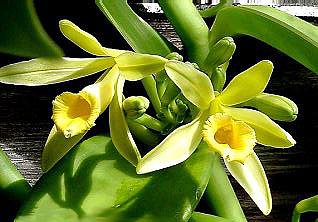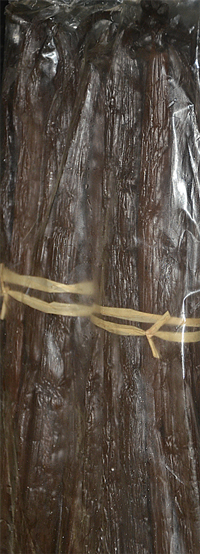

Vanilla
from Madagascar
Vanilla is a flavouring derived from
orchids of the genus Vanilla, which is native to
Mexico. Vanilla planifolia (syn. V.
fragrans), is the subspecies grown on
Madagascar. Vanilla planifolia, and its
closely related siblings V. pompona and V.
tahititensis are the only species, out of tens of
thousands of orchid species, and the only ones out
of the 110 species of Vanilla, who produce any
product for human consumption or use!
The
Totonac
people, who inhabit the
Mazatlan Valley on the Gulf Coast of
Mexico
in the present-day state of
Veracruz,
were the first to cultivate
vanilla. According to Totonac mythology, the
tropical orchid was born when Princess Xanat,
forbidden by her father from marrying a mortal, fled
to the forest with her lover. The lovers were
captured and beheaded. Where their blood touched the
ground, the vine of the tropical orchid grew.
The Vanilla from Madagascar is also known as Bourbon
Vanilla.

Vanilla Plant
For its
cultivation supporting trees are necessary. It
requires shade. It can be cultivated as an
intercrop in coconut, areca nut and Pepper
farms. Vanilla is propagated mainly by stem
cutting. The ideal time for planting vanilla is
when the weather is neither too rainy nor too
dry. August or September is the planting season.
Flowering Commences in the third year after
planting. Depending upon the place of
cultivation flowering is from December to March.
The ideal time
for pollination is 6 a.m to 12 noon. After
pollination the beans take 9-11 months for their
maturity. For its processing different methods
are adopted.
Once fully cured,
the vanilla beans are sorted by quality and
graded. Vanilla grades depend mostly on the
length of the bean, since there is a correlation
between length and vanillin content, they could
be Grade A, B or C. Vanilla has got a
multitude of uses in cooking, cosmetics,
aromatherapy etc.
Each vanilla
orchid blossoms for only a few hours and must be
pollinated by hand during that time. The bean is
odorless when harvested, becoming fragrant only
after it has been fermented and dried. This
complex process makes vanilla the second-most
expensive spice in the world (after saffron).
Oily, supple, dark brown or black beans are the
criteria for a good quality; a white film signifies exceptional quality.
We are suppliers of high quality vanilla from
Madagascar, meticulously selected and cured
For further
information about our Vanilla like availability,
grades, price, please
contact us
now.
Home

Bourbon Vanilla











